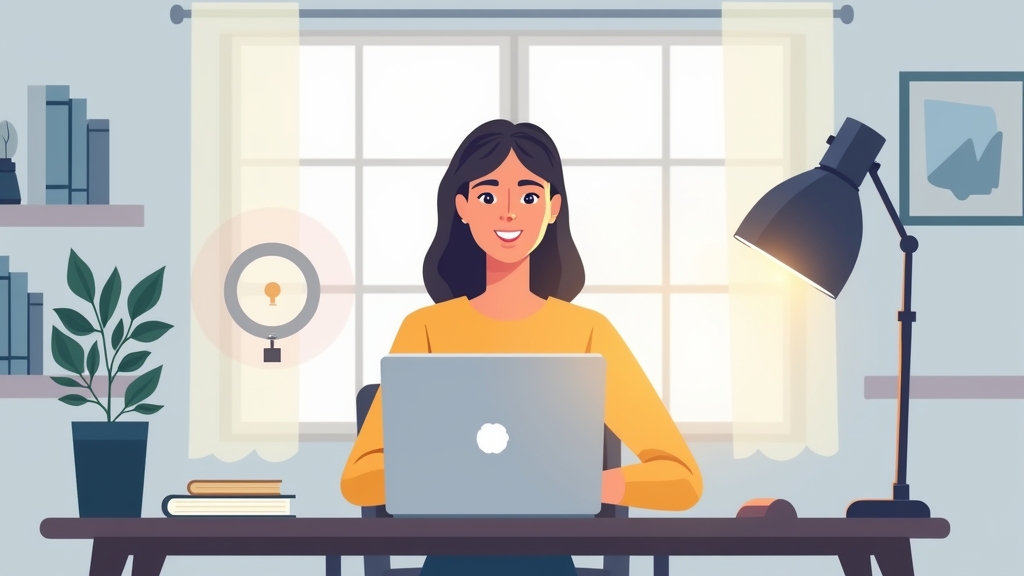Advertising
The importance of a good visual presentation in online interviews
Have you ever thought about how small visual details can influence the first impression in an interview? In a competitive market, where candidates vie for positions through screens, mastering visual language has become as crucial as preparing answers to behavioral questions. The truth is that recruiters form opinions in the first few seconds of connection, long before you even start talking about your professional qualifications. Imagine losing out on an incredible opportunity not because of your CV, but because the wrong lighting made you look tired or the wrong framing conveyed disorganization. These technical aspects, when neglected, can sabotage even the most prepared candidate, creating invisible barriers in the non-verbal communication that takes place through the camera.
Preparing the environment: the perfect setting for success
Before you even turn on the camera, carefully assess what will be behind you during the interview. An organized and professional background shows attention to detail and respect for the selection process. Avoid empty white walls that look impersonal, but also avoid flashy prints or cluttered shelves that steal the recruiter's attention. The ideal is to strike a balance between professionalism and personalityPerhaps an organized bookshelf with some books relevant to your area or a green plant that brings life to the room.
The choice of location should prioritize silence and privacy, ensuring that you won't be interrupted during the conversation. Test the acoustics of the room beforehand - some rooms can create echoes or pick up unwanted external noise. Close windows to avoid noise from the street and let people who live with you know the time of the interview to ensure privacy. These simple precautions prevent awkward situations and allow you to focus entirely on the conversation with the recruiter.
The right lighting: your best ally in a professional image
Natural light is your great ally for creating a healthy, natural look during video calls. Position yourself facing a window, allowing the light to evenly illuminate your face without creating harsh shadows or overexposed areas. Avoid facing away from light sources at all costsThis will turn your face into a dark silhouette, making it difficult for the interviewer to read your facial expressions. The ideal time is usually in the morning or late afternoon, when the sunlight is softer and more diffuse.
For night interviews or environments with little natural light, invest in quality artificial lighting. Three points of light create the most professional effect: a stronger main light at the front, a softer fill light to reduce shadows and a back light to separate you from the background. LED bulbs with a color temperature between 5000K and 6500K reproduce colors naturally, avoiding yellowish or bluish tones that distort your appearance. An adjustable light ring can be an affordable and efficient solution to ensure consistent lighting.
Mastering framing: ideal camera positioning
The height of the camera is a crucial detail that many overlook, but which makes all the difference to the interviewer's perception. Position the camera at eye level or slightly above, creating a natural angle and favoring your face. Avoid very low angles (which show your nostrils and can seem intimidating) or too high (which diminish your presence and can convey insecurity). Use books or an adjustable base if necessary to achieve the correct height, ensuring that you don't have to look down or up during the conversation.
Advertising

The classic and most professional framing shows from mid-chest height to just above the head, leaving a small space between the top of the head and the top edge of the frame. Keep a comfortable distance from the camera - neither so close that you invade the recruiter's personal space, nor so far away that you lose the visual connection. The eyes should be approximately in the top third of the frame, following the rule of thirds in photographic composition to create a visually balanced and pleasing image.
Fine technical adjustments: beyond the basics
The resolution and image quality of your camera deserve special attention, as they determine how clearly the recruiter will see you. Most of the webcams built into notebooks are of limited qualityso consider investing in an external webcam of at least 1080p if you do interviews frequently. Adjust the focus to ensure maximum sharpness and clean the lens regularly - a smudge invisible to the naked eye can diffuse your image during the call.
Audio configuration is equally important for clear, interference-free communication. Use an external microphone if possible, as built-in microphones often pick up ambient noise and echo. Pre-test your audio using tools such as Mic Tests to check quality and volume. Headphones with a built-in microphone can be a practical solution to avoid audio feedback and ensure that you hear every question perfectly.
Pre-tests and final checklist
Never underestimate the power of a full simulation before the real interview. Do a test call with a friend or use recordings to critically analyze your image, audio and posture. Observe details such as eye contact (are you looking at the camera or the screen?), involuntary movements and voice clarity. Ask for honest feedback on how you appear in the video - sometimes we notice things that go unnoticed by ourselves.
Create a checklist with all the important points to review minutes before the interview: lights on, camera at the correct height, microphone connected, notifications disabled and water nearby. Confirm that all the necessary applications are up to date and working, avoiding last-minute scares with mandatory updates. Having everything organized and tested significantly reduces anxiety and allows you to focus on what really matters: the conversation with the recruiter.
Remember that technical preparation is just one of the pillars for success in video interviews. Combine these lighting and framing tips with solid content about your experience and skills, and you'll be several steps ahead of the competition. How about taking thirty minutes today to test your current settings and identify what can be improved? Small adjustments make a huge difference to how you are perceived professionally - and can open doors to incredible opportunities.



